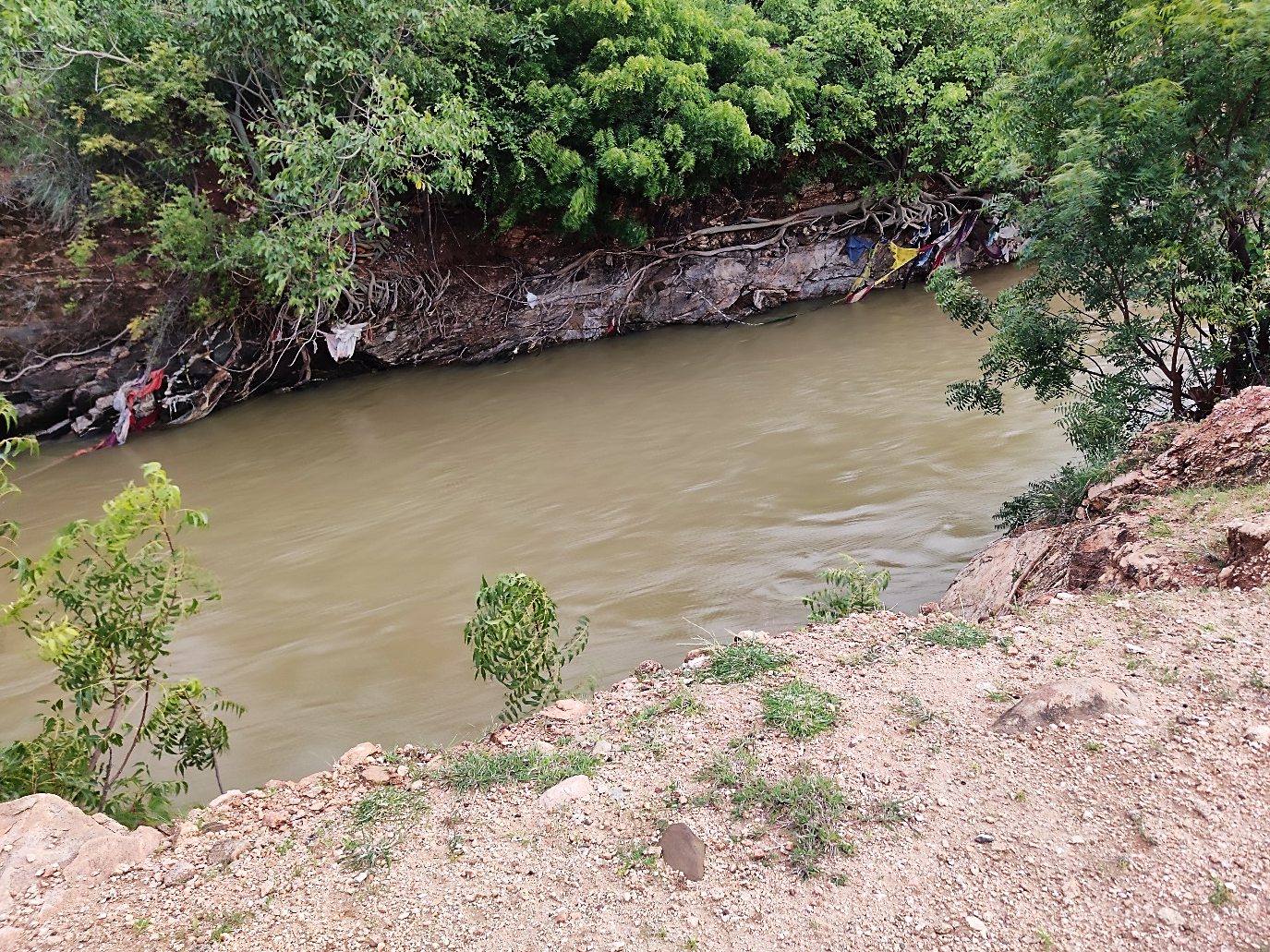By Meera Bhardwaj :
The Green Scrub Jungles along the Tungabhadra High Level Canal (HLC) reverberates with the melodious bird sounds and the long sawing roar of leopards, the loud huffing and sucking noise of sloth bears and the frequent squawks of peacocks. However, the new concrete road being constructed along a stretch of 15-kilometres of the Canal Service Road in Kamlapur, Vijayanagara district of Karnataka poses a serious threat to its Scrubland habitat and its unique avian heritage.
In fact, the new Canal Service Road that is undergoing construction work falls in Bilikal forest east (Daroji Bear Sanctuary) and Bilikal forest west (territorial area).
Open Scrub Forests with outcrops of rocks, this is an undulating landscape with stunted vegetation and exposed granite boulders. There are several huge rock caves that are inhabited by sloth bears and leopards. These were once inhabited by humans as rock cave paintings found in some parts of the district reveal.
THE TUNGABHADRA HIGH LEVEL CANAL UP TO ITS BRIM
Possessing the typical flora of the Deccan Plateau, the habitat along the High-Level Canal is home to a varied wildlife ranging from leopards, bears, pangolins, jackals, foxes, common and ruddy mongoose, wild boar, black-naped hare, Indian Civet as also more than110 bird species.
LEOPARDS ON THE HILLOCKS, PHOTO CREDIT: SHIVASHANKAR BANAGAR
In Daroji block of the Bear Sanctuary in Kamlapur, the Tungabhadra HLC flows in the middle and also along the periphery of the Sanctuary.
THE INDIAN SLOTH BEAR IN ITS ROCKY CAVES
Activists add, “Presently, works are still going on for cementing the canal embankments. Recently, the kutcha Service Canal Road was taken up for tarring a stretch of 15 kms from Hospete-Sanklapur village to Nallapura village and it is being developed just like a state highway.”
Road rollers and JCBs which stride across the service road disturb the landscape and no longer can one see the sand bath of the Painted Sandgrouse which camouflages itself in the stony scrublands.
A PERFECT HABITAT FOR PAINTED SANDGROUSE
Activists add the Canal Service Road often witnessed the Painted Sandgrouse and while going up and down the road, one could often see them taking a sand bath. If this road is tarred and gets ready for speedy traffic, the painted sandgrouse is likely to vanish.
THE INDIAN EAGLE OWL: PHOTO CREDIT: SAILENDRA PUNUKOLLU
Apart from this, the 27-Kilometre-long HLC was an attractive habitat for the Indian Eagle Owl but they have almost disappeared due to cementing of the crevices in the canal wall. The canal wall with its crevices provided an ideal habitat to these owls for many decades.
The High-Level Canal was built in 1958 and came up for modernization works in 2018. The Tungabhadra Board, an inter-state body took up the canal works on the Hospete side. This included modernization of canal lining, plugging the leakages and strengthening of canal banks as also contain any breaches.
THE STAR TORTOISE IN THIS SCRUB HABITAT
According to Karnataka Forest Department, the forests that have regenerated over a period of decades now supports a unique wildlife ecosystem including rich variety of bird species all along the High-Level Canal.
Speaking to Green Minute, PCCF and Head of Forest Force Sanjay Mohan said, “The matter will be looked into and we will see if the Canal Service Road could be retained as such to protect many a wildlife species that thrives in this landscape.”
BIRD DOCUMENTATION
THE WHITE THROATED KINGFISHER
A host of bird species have been recorded and documented in this region while the Scrub and Rocky terrain is a perfect habitat for Leopards and Sloth bears and other dryland species. In this background, environmentalists, birders and activists have called for immediate stoppage in the tarring of the Service Canal Road.
THE PAINTED SPURFOWL IN ITS SCRUB LANDSCAPE
As per eBird India (Bellary) documentation, 110 bird species have been recorded at the Tungabhadra High Level Canal. This is out of 312 bird species observed in the 37 hotspots of Ballari district. The top e-birders included Raju Ankasamudra, Vijay Ittigi, Ashwin Vishwanathan, Krishna Murthy, David Stanton, Shivprakash Adavanne, Sahana M, Rajeev Gejje, Subbu Subramanya, Dhruv Murali, Shreyas Punacha and 90 other top birders.
THE RED VENTED BULBUL
Some of the Species recorded under ebird include: Jungle Bush Quail, Indian Thick Knee, Yellow-Wattled Lapwing, Coppersmith Barbet, Common Babbler, Yellow throated Sparrow, Cormorant species, Sirkeer Malkoha, Syke’s Warbler, Jungle Myna, Brown fish-owl, Rock Bush-quail, Eurasian Sparrow-hawk, Black Redstart, Grey-necked Bunting and Richard’s/Blyth’s Pipit.
THE INDIAN SILVER BILL
Other species observed on this road include: Eurasian Hoopoe, Rosy Starling, Tri-colored Munia, Ashy-crowned Sparrow-lark, Laughing Dove, Indian Silver bill, Red-vented Bulbul, Indian Robin, Baya-weaver, Gray Francolin, Indian Nightjar, Green Bee-eater, Pied Bush chat, Rose-ringed Parakeet and Spotted Owlets.
The vegetation of Ballari territorial forest division varies from dry mixed deciduous type to thorny scrub types.
THE HIGH-LEVEL CANAL SCRUB HABITAT
Barring the Sandur forests and to some extent a number of forests in Hospete and Kudligi ranges which have some fairly good patches of dry mixed deciduous forest, most of the forest blocks of the territorial forest division, especially in the eastern part, harbour large extents of scrub forests which tend to be thorny bushes in the driest localities. And this habitat is ideal for many rare, endangered and native bird species.
Owing to stringent conservation practices by the forest department with the support of local NGOs and wildlife activists, the Daroji sanctuary has been regenerated and the entire ecosystem has undergone a metamorphosis. The entire luxuriant flora present has regenerated from the stumps and due to seed dispersal done by bears and birds.
Once a barren and degraded jungle, it has now become a verdant green forest. Innumerable species of plants typical to the North Karnataka Scrub Forest are seen here.
And during the monsoons, one sees the dance of the peacock, the call of the avian and the sloth bears’ search for termites in this unique landscape.

